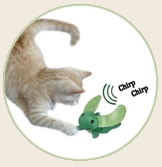| COMMON FACTS ABOUT CATS | ||||||
Updated: 25th October 2006 |
||||||
The Science of CatnipAmong the many mysteries that surround the feline species, their reactions to catnip (or Nepeta cataria, as a botanist would call it) are still not completely understood, but it's believed that receptors in a cat's nose and mouth transmit the herb's unusual effects throughout the cat's system. FACT: Catnip oil is an effective natural insect repellent! It's interesting to note that kittens have no sensitivity to catnip! That is, until they are about 12 weeks old. By then, their olfactory receptors will have developed enough to produce the classic kitty reaction to catnip. However, some cats, due to genetics, lack the special receptors necessary to experience the effects of catnip. The sensitivity to catnip is inherited; if a kitten has only one parent who gets pleasure from catnip, then that kitten has a one-in-two chance of growing up to enjoy catnip. TIP: If you buy bagged catnip for your cats, be aware that the nepetalactone in catnip will degrade over time and the catnip will lose its potency -- unless you store it in your freezer where the nepetalactone's properties will remain intact. Catnip stimulates felines, but humans who use catnip in folk remedies report its effects as relaxing. In the "old days," catnip tea was brewed to ease the symptoms of colic in infants; poultices made from catnip were applied to relieve toothaches. In fact, this herb has been used as a remedy for all sorts of ailments from cramps to hives and even to prevent nightmares! In modern times, catnip oil has been used by forest rangers to attract and trap mountain lions! It's also sold in tablet form as a supplement to support a healthy immune system in humans. Tea manufacturers still use catnip leaves in special blends of tea. Of course, cat owners know catnip best as a treat for their beloved pets. Catnip is sold bagged (as dried leaves and blossoms), stuffed into cat toys, or packed into cat scratching pads, posts, and trees. TIP: Here's a way your cat can enjoy loose catnip without leaving a big mess for you to clean up! Sprinkle a little inside a laundry basket or good-size cardboard box. You cat can flip, flop, and roll around with glee without spreading the catnip all over your floor! |
|
|
 |
It's getting time to bring the outdoors inside. Start  with this squeaking grasshopper. This may look like an average grasshopper, but give it the slightest tap and it will chirp and squeak it way into your cats hearts. 3 1/2"x1 with this squeaking grasshopper. This may look like an average grasshopper, but give it the slightest tap and it will chirp and squeak it way into your cats hearts. 3 1/2"x1 |
